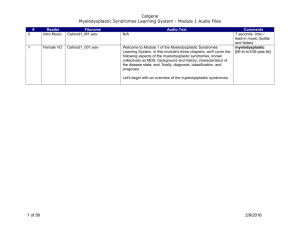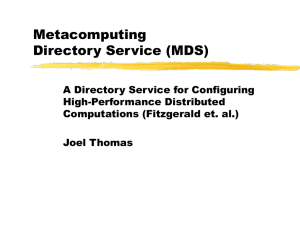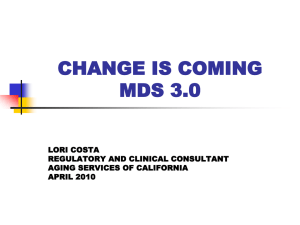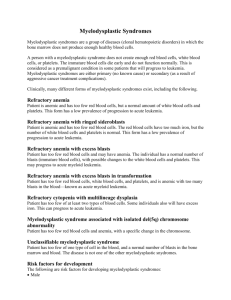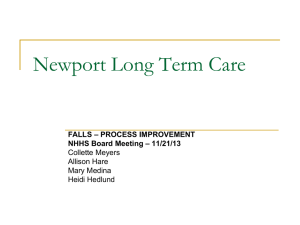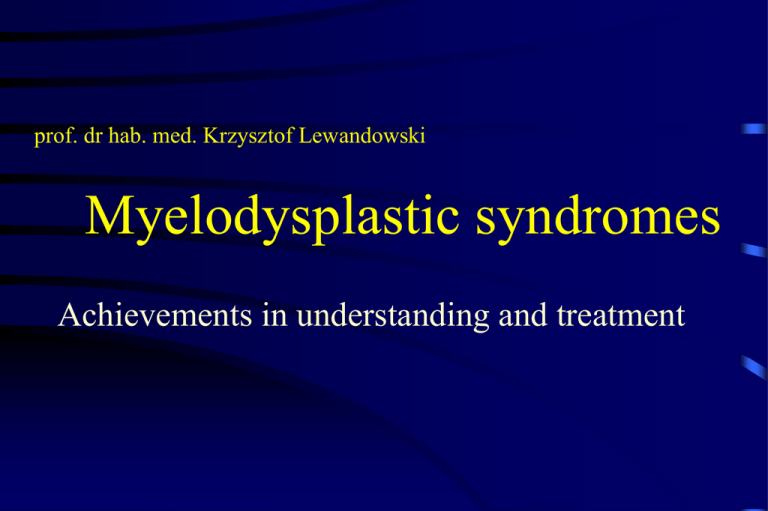
prof. dr hab. med. Krzysztof Lewandowski
Myelodysplastic syndromes
Achievements in understanding and treatment
Classification of Myeloid Neoplasms According to
the 2008 World Health Organization Classification Scheme
Myelodysplastic syndromes (MDS)
• The myelodysplastic (MDS) are a very heterogeneous
group of myeloid disorders characterized by peripheral
blood cytopenias and increased risk of transformation to
acute myelogenous leukemia (AML)
Some of the deregulated pathways for the
upregulated and downregulated genes in
MDS CD34+ cells
Li J. Int. J. Cancer: 000, 000–000 (2012)
Deregulated pathways in CD34ţ cells from MDS subtypes
RA and RAEB2 compared with in healthy controls
Li J. Int. J. Cancer: 000, 000–000 (2012)
Proposed mechanisms of miRNA in MDS
pathogenesis
Genetic and epigenetic abnormalities
may occur in both
osteoblasts and HSCs, which result in
the deregulation of certain
miRNAs in those cells. MiRNA
deregulation is followed by the
subsequent abnormal expression of
HSC extrinsic regulators in
osteoblasts or HSC intrinsic regulators
in HSCs, both leading to
HSC dysfunction and MDS
development
Li J. Int. J. Cancer: 000, 000–000 (2012)
Frequency
•
• In the US: The actual incidence is unknown. MDS
was first considered a separate disease in 1976, and
occurrence was estimated at 1500 new cases every
year. At that time, only patients with less than 5%
blasts were considered to have this disorder
• Statistics from 1999 show that 13,000 new cases occur
per year (approximately 1000 cases each year in
children)
• Internationally: The disease is found worldwide and
is similar in characteristics throughout the world
Epidemiology
• Sex: A slight male predominance is noted in all age
groups.
• Age: MDS primarily affects elderly people, with the
median onset in the seventh decade of life.
• The median age of these patients is 65 years, with ages
ranging from the early third decade of life to older than
80 years.
• The syndrome may occur in persons of any age group,
including the pediatric population.
MDS diagnosis
• Is based on morphological evidence of dysplasia
upon visual examination of a bone marrow aspirate
and biopsy
• Information obtained from additional studies such
as karyotype, flow cytometry, or molecular genetics
is complementary but not diagnostic
MDS- diagnosis (2)
• Aplastic anaemia and some disease accompanied by
marrow dysplasia, including wit. B12 and/or folate
deficiency, exposure to heavy metals, recent
cytotoxic therapy and ongoing inflammation
(including HIV and chronic liver disease/alcohol
use) should be ruled out
MDS – clinical findings
• These are non-specific, and are usually the consequences
of cytopenias, including:
- symptoms of anaemia
- infections due to neutropenia, but also to the frequently
associated defect in neutrophil function
- bleeding due to thrombocytopenia (may also occur in
moderately thrombocytopenic patients or even in patients
with normal platelets count, because of its abnormal
function)
Myelodysplastic syndromes
WHO classification system
Myelodysplastic syndromes:
• Refractory anemia (RA)
With ringed sideroblasts (RARS)
Without ringed sideroblasts
• Refractory cytopenia (MDS) with multilineage dysplasia (RCMD)
• Refractory anemia with excess blasts (RAEB)
• 5q- syndrome
Myelodysplastic syndrome, unclassifiable
• Myelodysplastic/Myeloprolipherative diseases
• Chronic myelomonocytic leukemia (CMML)
• Atypic chronic myelogenous leukemia (aCML)
WHO 2008 MDS classification
Garcia-Manero G. Am. J. Hematol. 2011;86:491–498
Myelodysplastic syndromes
IPSS risk-based classification system
Marrow blast percentage:
•
•
•
•
<5
5-10
11-20
21-30
0
0.5
1.5
2.0
Cytogenetic features
• Good prognosis
0
(–Y, 5q- , 20q-)
• Intermediate prognosis
0.5
(+8, miscellaneous single abnormality, double abnormalities)
• Poor prognosis
1.0
(abnor. 7, complex- >3 abnor.)
Cytopenias
• None or one type
• 2 or 3 type
0
0.5
Myelodysplastic syndromes
Overall IPSS score and survival
Overall score:
low
• 0
Intermediate
• 1 (0.5 or 1)
• 2 (1.5 or 2)
High
• > 2.5
Median survival:
5.7 years
3.5 years
1.2 years
0.4 years
Refined WHO Classification–Based Prognostic Scoring
System (WPSS) of Myelodysplastic Syndromes
Cazzola M et al. Semin Oncol 2011;38:627-634
Kaplan-Meier survival curves of 943 patients
diagnosed with MDS according to the 2008 WHO criteria
Cazzola M et al. Semin Oncol 2011;38:627-634
Myelodysplastic syndromes: 2011 update on
diagnosis, risk stratification, and management
American Journal of Hematology 2011; 86, 490-498, 18 MAY 2011 DOI: 10.1002/ajh.22047
Bone marrow biopsy
• Blood examination and bone marrow aspirate are
sufficient for a diagnosis of MDS
- normal or increased cellularity is seen in 85-90% od
cases
- abnormal localization of immature precursors (ALIP)
- fibrosis (significant in 15-20% of cases)
Myelodysplastic features in MDS
MDS
Dyserythropoiesis
Bone marrow and/or peripheral
blood findings
Bone marrow: multinuclearity,
nuclear fragments,
megaloblastoid changes,
cytoplasmic abnormalities,
ringed sideroblasts
Peripheral blood:
poikilocytosis, anisocytosis,
nucleated red blood cells
Myelodysplastic features in MDS
MDS
Dysgranulopoiesis
Dysmegakariopoiesis
Bone marrow and/or peripheral
blood findings
Nuclear abnormalities
including: hypolobulation, ringshaped nuclei, hypogranulation
Micromegakariocytes
Large mononuclear forms
Multiple small nuclei
RAEB-2. Bone marrow, 100x
RAEB-2 . Bone marrow, 400x
RAEB-2. Bone marrow, 400x (2)
RAEB-2. Bone marrow 400x (2)
MDS with ring sideroblasts. Bone marrow 400x
Frequency of cytogenetic alternations in MDS
Garcia-Manero G. Am. J. Hematol. 2011;86:491–498
MDS therapy
Options for newly diagnosed patients with lower risk MDS
• Therapy in this subset of patients is based on the
transfusion needs of the patients
• Patients that are transfusion independent are usually
observed until they become transfusion dependent
• Erythroid growth factor and granulocyte growth factor
support (ESA, G-CSF)
• Lenalidomide (is approved in the US for patients with lower risk
MDS, anemia, and alteration of chromosome 5)
Management of progressive or refractory
disease
• At the present time, there are no approved interventions
for patients with progressive or refractory disease
particularly after hypomethylating based therapy.
Options include cytarabine-based therapy,
transplantation, and participation on a clinical trial.
Myelodysplastic syndromes: 2011 update on
diagnosis, risk stratification, and management
American Journal of Hematology
Volume 86, Issue 6, pages 490-498, 18 MAY 2011 DOI: 10.1002/ajh.22047
http://onlinelibrary.wiley.com/doi/10.1002/ajh.22047/full#fig2
Probability of survival after allogeneic transplant for
MDS, age <20 years, by disease status and donor type,
1998-2008
100
100
Probability of Survival, %
90
90
Early, unrelated (N=145)
80
70
80
70
Early, HLA-matched sibling (N=63)
60
60
Advanced, HLA-matched sibling (N=114)
50
40
50
40
Advanced, unrelated (N=190)
30
30
20
20
10
10
P = 0.002
0
0
0
1
2
3
4
5
6
Years
SUM10_39.ppt
Probability of survival after allogeneic transplant for
MDS, age 20 years, by disease status and donor type,
1998-2008
Probability of Survival, %
100
100
90
90
80
80
70
70
Early, unrelated (N=509)
60
60
Early, HLA-matched sibling (N=599)
50
50
40
40
30
30
Advanced, unrelated (N=1,142)
20
20
Advanced, HLA-matched sibling (N=1,237)
10
10
P < 0.0001
0
0
0
1
2
3
4
5
6
Years
SUM10_40.ppt
Probability of survival after allogeneic transplant for
MDS with reduced-intensity conditioning, by disease
status and donor type, 1998-2008
Probability of Survival, %
100
100
90
90
80
80
70
70
Advanced, HLA-matched sibling (N=366)
60
60
Early, HLA-matched sibling (N=217)
50
50
Early, unrelated (N=202)
40
40
30
30
20
20
Advanced, unrelated (N=383)
10
10
P < 0.0001
0
0
0
1
2
3
4
5
6
Years
SUM10_41.ppt


